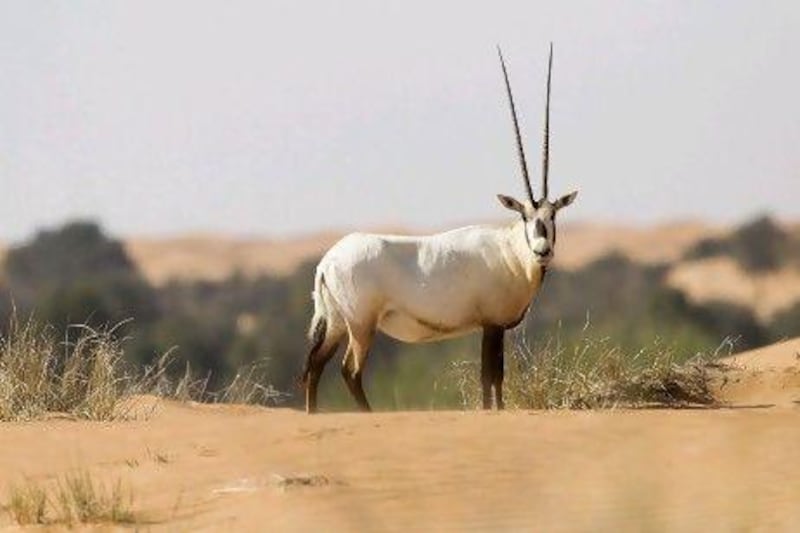DUBAI // The UAE's role in rescuing the Arabian oryx, the animal that came back from the dead, is sometimes overlooked in stories of the beloved beast's shift in fortunes, a wildlife expert says.
The Arabian Peninsula's signature species, with its distinctive white coat and long black horns, was hunted to extinction in the wild 40 years ago.
Today it is thriving, thanks to captive breeding and reintroduction programmes.
Last June, the species' threat level was downgraded from "endangered" to "vulnerable" in the red list published by the International Union for Conservation of Nature - the first time this had happened to an animal that had been declared extinct in the wild.
The account most often told describes how the last few animals were rounded up in Arabia and shipped to Phoenix Zoo in the United States, where captive breeding saved the day.
The Phoenix Zoo's website says the zoo "is credited with saving the Arabian oryx from extinction", and adds: "In 1962, they started the first captive-breeding herd in any zoo."
But Dr Reza Khan, wildlife and zoo specialist at Dubai Municipality, says members of the founding President Sheikh Zayed's family were already breeding the animal successfully at that time, if not earlier.
"Phoenix Zoo in Arizona became the so-called first captive breeder in the world," Dr Khan said. "I know for sure the family of Sheikh Zayed bred the oryx in captivity at least from the 1960s."
Dr Khan went to work at Al Ain Zoo in 1983 and was told about the UAE's early successes with captive breeding by Otto Bulart, who was then its director.
Al Ain Zoo had begun its own breeding programme in 1968 when, on Sheikh Zayed's orders, the last four animals left in the wild were rounded up and taken there. Other animals from private collections were used to establish a herd at Sir Bani Yas Island.
"In Al Ain Zoo, there was nothing special about it breeding; it breeds like hell once a pair starts to do so," he said.
"In the West, zoos and conservation organisation bang their heads to breed it.
"At the time of my joining there were more than 70 oryx, making it possibly the largest herd in captivity. But it was not known to the world as the international yearbooks published by the Zoological Society of London never mentioned the Arabian oryx in Al Ain Zoo."
One factor behind the lack of awareness of the zoo's captive breeding success was Mr Bulart's reluctance to draw attention to it. "He was a great man but a kind of introvert, not keeping up any communication with the world zoo community."
Greg Simkins, conservation manager at the Dubai Desert Conservation Reserve, which has more than 400 oryx, said: "All species should be saved, but the iconic status of the Arabian oryx allows it to be used as a flagship species for broad-scale conservation and protection programmes."
Reintroducing it into its natural habitat was a complex task, he said, requiring genetic management of the herd, transportation and release of the animals and then management and monitoring of the animals after release.
The species - Latin name, Oryx leucoryx - has evolved to cope with the scorching heat of the Arabian summer in a number of ways.
The animal's white coat reflects heat from the sun; its body temperature rises on hot days and the excess heat is released during the cooler hours of the night. The camel performs a similar trick, but the oryx reaches much higher temperatures.
In addition, the temperature of the blood entering the brain is kept much lower than the body temperature. The oryx manages this by running the blood being pumped to the brain past other blood that has travelled through the nasal passages, which has been cooled by panting and the evaporation of fluid.
Oryx obtain water by eating plants with a high liquid content and feeding when the air is humid, to reduce evaporation as they eat. This way, they can survive for as long as nine months without drinking.
This ability to live in such a harsh environment is one of the things that makes the oryx special, says Mr Simkins.
"As the largest wild animal on the Arabian peninsula, it formed an important part of the Bedouin culture, a source of food and material [leather]. But it was also revered for its beauty in poetry, and Maha - the Arabic word for oryx - is a common woman's name."






